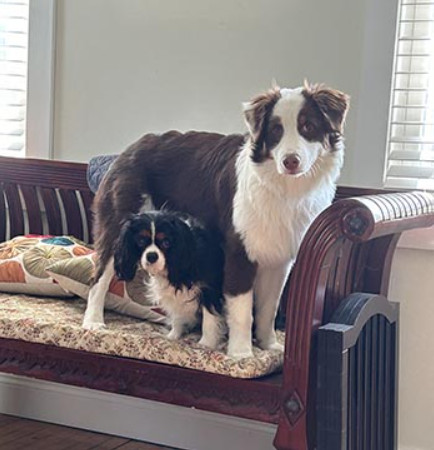 See that cute little Cavalier there… safely tucked under her big Aussie brother’s belly. She’s there seeking cover because she just finished barking her head off at the postman stopped in front of our house. But then, when he actually walked up to the front door… Well, not so tough anymore.
See that cute little Cavalier there… safely tucked under her big Aussie brother’s belly. She’s there seeking cover because she just finished barking her head off at the postman stopped in front of our house. But then, when he actually walked up to the front door… Well, not so tough anymore.
Yup, she’s got a touch of the case of “Small Dog Syndrome.” Since I’m working it through with her, I thought I’d share what it is, what causes it, and what you can do about it.
What is Small Dog Syndrome?
 We love our small dogs for their cuteness, portability, and charm. Whether it’s a Chihuahua tucked into a purse or a Pomeranian bouncing around with boundless energy, these pint-sized pups can bring a lot of joy to their owners. However, despite their diminutive size, small dogs can sometimes develop behaviors that are anything but tiny. This phenomenon is commonly referred to as “small dog syndrome.”
We love our small dogs for their cuteness, portability, and charm. Whether it’s a Chihuahua tucked into a purse or a Pomeranian bouncing around with boundless energy, these pint-sized pups can bring a lot of joy to their owners. However, despite their diminutive size, small dogs can sometimes develop behaviors that are anything but tiny. This phenomenon is commonly referred to as “small dog syndrome.”
Small dog syndrome isn’t a medical condition but rather a collection of behavioral issues commonly exhibited by smaller breeds. Dogs suffering from small dog syndrome often display problematic behaviors, such as excessive barking, aggression toward other dogs or people, resource guarding, and an overall lack of obedience. (Luckily, I’m only dealing with excessive barking with Kenzie.)
These behaviors can make daily life with a small dog stressful and may lead to social issues with other dogs and humans. What’s ironic is that many of these behaviors stem from human actions and perceptions rather than inherent personality traits of the dogs themselves.
Common Behaviors Associated with Small Dog Syndrome
- Excessive Barking: Small dogs are known for being yappy, but incessant barking is a hallmark of small dog syndrome. This often occurs because the dog feels insecure or overexcited and hasn’t been taught when barking is appropriate.
- Aggression Toward Other Dogs: Despite their small size, these dogs can become overly aggressive toward larger dogs. This is frequently a result of fear or a learned behavior stemming from their environment. According to a study conducted by the University of Veterinary Medicine in Vienna, small dogs are 60% more likely to exhibit aggressive behaviors, including biting, compared to larger breeds.
- Demanding Behavior: Dogs with small dog syndrome may bark, whine, or paw at their owners to demand attention, food, or play. When these demands are met, it reinforces the behavior.
- Jumping Up on People: Many small dogs are allowed to jump up on people because they’re not as physically intimidating as larger breeds. However, this can lead to unruly behavior and a lack of respect for personal space.
- Resistance to Training: Some small dog owners believe their dogs don’t need as much training as larger breeds, leading to dogs that are poorly socialized and lacking in basic obedience.
Causes of Small Dog Syndrome
Small dog syndrome is largely the result of human behavior. Here are some of the key factors that contribute to its development:
- Overcompensation: Owners of small dogs may unconsciously overcompensate for their dog’s size by being overly protective. Carrying the dog everywhere, avoiding interactions with larger dogs, and constantly coddling can make the dog feel more dependent and insecure.
- Lack of Training: There’s a misconception that small dogs don’t need training because they’re easier to manage physically. This can lead to a lack of structure and discipline, which is essential for any dog, regardless of size.
- Inconsistent Rules: Owners may allow small dogs to get away with behaviors they wouldn’t tolerate in a larger dog, such as jumping on furniture, barking excessively, or pulling on the leash.
- Unintentional Reinforcement: When owners respond to unwanted behaviors like barking or whining by giving attention or treats, they unintentionally reinforce those behaviors.
Consequences of Small Dog Syndrome
While small dog syndrome might seem harmless, it can have several negative consequences for both the dog and its owner:
- Increased Stress for the Dog: Dogs with small dog syndrome often live in a heightened state of anxiety. Without clear leadership and consistent boundaries, they may feel the need to take on a protective role, leading to chronic stress.
- Difficulty in Social Situations: A small dog that barks excessively or acts aggressively toward other dogs can create uncomfortable situations in public settings. This can lead to fewer opportunities for socialization, which only exacerbates the problem.
- Risk of Injury: Aggressive behavior toward larger dogs can put a small dog at risk of serious injury. Even if the larger dog isn’t aggressive, a defensive reaction could hurt the smaller dog. Statistics indicate that small dogs are 40% more likely to be injured in altercations with other dogs due to their fragile size and aggressive tendencies.
- Strained Owner-Dog Relationship: Constant barking, demanding behavior, and lack of obedience can strain the bond between owner and dog, making the relationship less enjoyable.
How to Prevent or Correct Small Dog Syndrome
The good news is that small dog syndrome can be prevented or corrected with proper training, consistency, and positive reinforcement. Here are some tips:
-
Treat Your Small Dog Like a Big Dog
- Set consistent rules and boundaries for your dog, just as you would with a larger breed.
- Don’t allow behaviors that wouldn’t be acceptable in a larger dog, such as jumping on people or barking excessively.
-
Provide Proper Training
- Start training early and be consistent. Teach basic commands like sit, stay, and come.
- Use positive reinforcement to encourage good behavior. Reward your dog with treats, praise, or play when they follow commands.
-
Socialize Your Dog
- Expose your dog to a variety of people, dogs, and environments from a young age. This helps build confidence and reduces fear-based behaviors.
- Make sure social interactions are positive and safe. Avoid overwhelming your dog by introducing them to too many new experiences at once.
-
Avoid Over-Coddling
- While it’s natural to want to protect your small dog, it’s important not to overdo it. Allow your dog to walk on their own, explore their environment, and interact with other dogs under supervision.
- Encourage independence by giving your dog opportunities to solve problems and make choices.
-
Be a Confident Leader
- Dogs, regardless of size, look to their owners for guidance and leadership. Be calm, assertive, and consistent in your interactions with your dog.
- Avoid yelling or using harsh punishments, as these can increase anxiety and worsen behavioral issues.
-
Provide Mental and Physical Stimulation
- Small dogs need exercise too! Regular walks, playtime, and mental stimulation through puzzle toys or training sessions can help reduce unwanted behaviors.
- A tired dog is often a well-behaved dog.
When to Seek Professional Help
If your small dog’s behavior doesn’t improve with consistent training and boundaries, consider seeking help from a professional dog trainer or behaviorist. They can provide tailored advice and techniques to address specific issues.
Final Thoughts
Small dog syndrome is a common but preventable set of behaviors often caused by us well-meaning humans. By understanding the root causes and taking proactive steps to provide training, socialization, and clear leadership, you can ensure your small dog grows into a well-behaved, confident companion.
Remember, size doesn’t dictate the need for training and boundaries—all dogs thrive when they have clear rules, regular exercise, and lots of love. With patience and consistency, even the smallest dogs can learn to behave.


Related Posts: